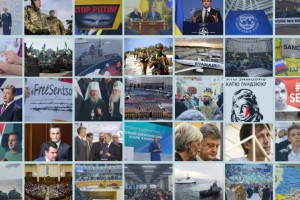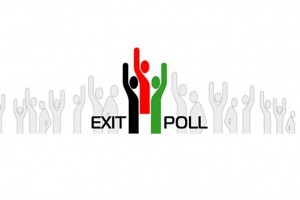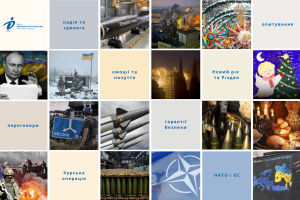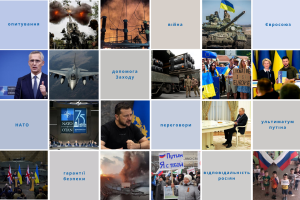Corruption in the everyday lives of Ukrainians: For what do we give bribes? To whom and why?
A nationwide polling of the population of Ukraine was held from September 18 to October 3, 2017 by the Ilko Kucheriv Democratic Initiatives Foundation and the Ukrainian Sociology Service company. A total of 2,000 respondents were polled by a sample, which represents the adult population of Ukraine (with the exception of the occupied territories of Crimea and separate territories in the Donetsk and Luhansk oblasts). The margin of error of the sample does not exceed 2.3%.
The polling was conducted with the financial support of the Ministry of Foreign Affairs of the Czech Republic.
- Nearly half of the population – 44% – considers corruption to be the most serious problem in Ukraine and another 36% consider it quite serious. Only 2% of the population are certain that the problem of corruption was fabricated and 12% do not consider it a serious problem.
- The prevalence of corruption in our country is assessed by the population as extraordinarily high: 90% consider that corruption is highly prevalent, 50% of the polled noted that corruption is extremely prevalent and nearly 38% – that this phenomenon is sufficiently prevalent.
- According to the population of Ukraine, the most corrupt institutions are the courts (52% of the polled noted that corruption in these institutions is very prevalent), the Verkhovna Rada (51% of the corresponding assessments), the Prosecutor General’s Office (45%), the Government (43%), the customs (39%), medical institutions (39%). At the same time, the overwhelming majority of organizations and institutions are assessed as corrupt and the positive assessments prevail over the negative only regarding the Church (+32%), non-governmental organizations (+11%) and the mass media (+1%). Meanwhile, the Verkhovna Rada (-75%), the courts (-73%) and medical institutions (-71%) show the lowest indicators (most corrupt), while the church, non-governmental organizations and the mass media are considered to be the least corrupt.
- The people’s attitudes towards bribery are ambiguous. In particular, only 49% of the population assessed bribery as inadmissible, while 44% partially or fully justify it: as a “negative phenomenon, but in some cases it can be justified” (35%) or even as “a normal way of quick and effective problem solving” (9%). In the regional dimension residents of the Center and the Donbas give the most stringent assessments (there 58% and 57%, respectively, believe that bribery is an inadmissible phenomenon), while residents of the South gave the most lenient assessments (among them 59% in one way or another justify this phenomenon).
- In the assessment of the corruption dynamics in our country compared to 2014 negative trends somewhat prevail. Specifically, according to the 44% of the polled, corruption significantly or slightly grew, while only around 4% noted its decline (nearly 39% consider that it remained at the same level). Residents of the Donbas and the East (nearly 54% and 48% of the polled in the respective regions) most often noted the growth of corruption, while the residents of the West relatively less frequently noted such growth (about 39% of those polled).
- Among those who over the past year personally came up against situations in which they had to give a bribe, the majority (51%) did so in medical institutions. Such situations were also relatively frequent in high schools (24%), in local bodies (around 15%), schools (11%) and in relations with the patrol police (around 11%). Accordingly, the most widespread cases of giving bribes were additional payment in medical institutions (38% of those who gave a bribe over the past year), admission to higher educational institutions (18%), admission to schools, registration to kindergartens (17%).
- The majority of those who gave a bribe (53%) did this on the basis of information received directly from the employees of institutions they turned to: 27% were given a hint about such actions, while a bribe was openly demanded from 26%. Another 20% gave a bribe because they were convinced of its necessity. At the same time, there are considerable regional differences: residents of the East of Ukraine much more frequently faced a direct demand of bribe, while the residents of the South encountered such a situation most rarely. However, oriented themselves on their own personal knowledge (regarding the necessity of giving bribe) more often the residents of the West (30%) and the South (28%).
- A third of those who over the past year gave a bribe did so because, in their opinion, if they did not do so, their problem would not be solved, while around 40% did this to more quickly solve their problem (that is, the problem would eventually be solved, but not as quickly as desired).
- As to the prospects of uprooting corruption in Ukraine, the opinions of citizens were divided: 30% believe that this is a realistic goal, 39% – it is not realistic, and another 31% could not give a definite answer. Residents of the East are the most pessimistic about the prospects of uprooting corruption (among them nearly half do not see such prospects) and in the Donbas (there 45% could not give a direct response), but in all regions of Ukraine the share of pessimists and those who are in doubt is significantly higher than the share of optimists.
- The most effective measures in the fight against corruption, according to respondents, are: strengthening of criminal punishment for corruption (the average grade was 3.5 on a scale of 5[1]), the work of specialized anti-corruption bodies (average grade 3.2) and introducing legal examination of all normative acts (average grade 3.1). Meanwhile, respondents believe that performing an attestation of civil servants (average grade 2.4), raising salaries of civil servants (average grade 2.6), lustration (cleansing) of state bodies (average grade 2.9) are the least effective measures. At the same time, the above indicators show that the assessment of effectiveness of all measures is approximately at the average level, meaning none of the measures are considered sufficiently effective or very effective.
- Among the actors capable of fighting corruption the following were named most frequently: citizens themselves (39% of the polled), the president (37%), specialized anti-corruption bodies (34%), mass media (33%) and the prosecutor’s office (33%). At the same time, the people put the least hope on political parties (10%), local authorities (11%) and tax bodies (11%). Herewith it is worth noting that the variant of an independent fight against corruption by citizens is in the first place among residents of the central region of Ukraine, while residents of the West, South and the Donbas first and foremost place their hopes on the president.
- Medical institutions are leading in everyday corruption practices: among those who have paid something to the medical staff over the past 3 years about 16% said they did it on a regular basis, while the overwhelming majority (42%) did it occasionally and 40% rarely did this. Residents of the western region gave bribes more frequently (among them 25% of the polled did this on a regular basis) and in the Donbas nearly 21% of the polled did this regularly. Meanwhile, such situations were less frequent among citizens of the South (among them 62% said they rarely had to give bribes).
- In those cases when one had to pay for services in state healthcare institutions this was done mainly in cash form without a receipt ( in this form it was carried out by 54% of those who encountered such situations). Slightly more than a quarter of the polled in the corresponding group paid in cash form to a cashier or in cash form by a receipt. Residents of the West (69% of those who paid for services) more frequently noted payment without a receipt, while among residents of the Donbas a large share (40% of those who paid for services) paid in kind, meaning in the form of a gift.
- The payment was assessed as quite burdensome for those who had performed it. In particular, around 25% in this group of respondents had to borrow money to do this payment and about 33% estimated the sum of the payment as large, burden on the family budget.
- The overwhelming majority of payments went directly into the pocket of the doctor who rendered such services. 75% of those who were forced to paying a bribe did so in this way. Besides, nearly one fourth of those respondents paid nurses. In such cases, residents of the West (36%) and the Donbas (35%) showed their gratitude to nurses in cash form slightly more often. In addition to that, representatives of these two regions notably more often (23% and 26% respectively) noted payments to medical orderlies (less than 10% of those polled in other regions mentioned such payments).
- More than half (58%) of those who paid a bribe for receiving medical services in state institutions did so before the start of treatment, while nearly one fourth of this group of respondents paid during or after treatment. A certain part of this group (about 10%) stated that they paid before, during and after treatment; where residents of the western region of the country accounted for the slightly larger share.
- Slightly more than half (52%) of those who paid bribes for receiving medical services in state institutions noted that they did so because employees of the institution directly told them that this was compulsory, while another 29% said that they were given hints that if they did not pay a bribe they wouldn’t be provided with quality service. Meanwhile, only around 14% of those who gave a bribe said that it was done on their own initiative. Residents of the East (64%) and the Center (57%) most frequently came up against situations of direct extortion, while residents of the Western and Southern regions relatively more frequently said such an action was of their own initiative (in both regions this figure was 23%).
- Regarding the most effective methods of eliminating corruption in the medical sphere, respondents most frequently mentioned the introduction of medical insurance (36%), dismissal of bribe-takers (33%) and criminal liability for manifestations of corruption (33%). Herewith, residents of the Donbas region considerably more frequently mentioned punitive measures (42% and 63% respectively). Noteworthy is that a very insignificant share of the polled (3%) believes that none of the measures can uproot corruption in the medical sphere.
[1] Evaluation of various anti-corruption measures was based on a 5-point scale, where 1 point meant “totally ineffective” and 5 points meant “very effective”.








